"You should start a blog!" If you've cooked for your friends and heard something like this, you might be ready to take the next step. Lots of popular social media chefs were encouraged by friends to publish their recipes, experiences, and commentary online. Even professional chefs, like Gordon Ramsay, have switched from cook-offs and competitions to documenting their culinary experiences around the world.
So, how can you create your own food blog, and what should you pay attention to? In this guide, we'll let you know how you can start a blog that's all about cooking and eating, and what ingredients you'll need.
Why Start a Food Blog?
Joy in cooking (or maybe just eating) is an important factor in launching a food blog, especially since any lack of it will become clear fast. However, there are also more practical (monetary) reasons: Food blogging isn't just a fun hobby, but also one of, if not the most profitable type of blogging.
So, if you'd like to share your culinary passion with others, and earn a little bit (or a lot of) money in the process, a food blog might be worth seriously considering.
The 5 Key Ingredients of a Food Blog
Think of a food blog like a homemade dish: Even though it's always made with the same ingredients, it's unmistakable and one of a kind. Make sure that your blog ticks the following boxes:
1. Unique niche or perspective
Food bloggers are a dime a dozen these days, making it difficult to stand out from the crowd. One way to do this is to specialize in something that few others do. Perhaps it's a specific type of cooking (e.g. healthy, gluten-free, regional), a certain dish with lots of variations, an entire culinary tradition, or special tools (like an air fryer).2. Clear and comfortable brand identity
Once you've determined what your niche should be, it's time to think about your brand identity. Visitors to your blog should have a basic idea of what they can expect before they open their first recipe. A good example is the Australian blogger, Nagi, from recipetineats. In her "About Me" section, she highlights the four guiding principles of her cooking philosophy: fast, creative, clever, and fresh.
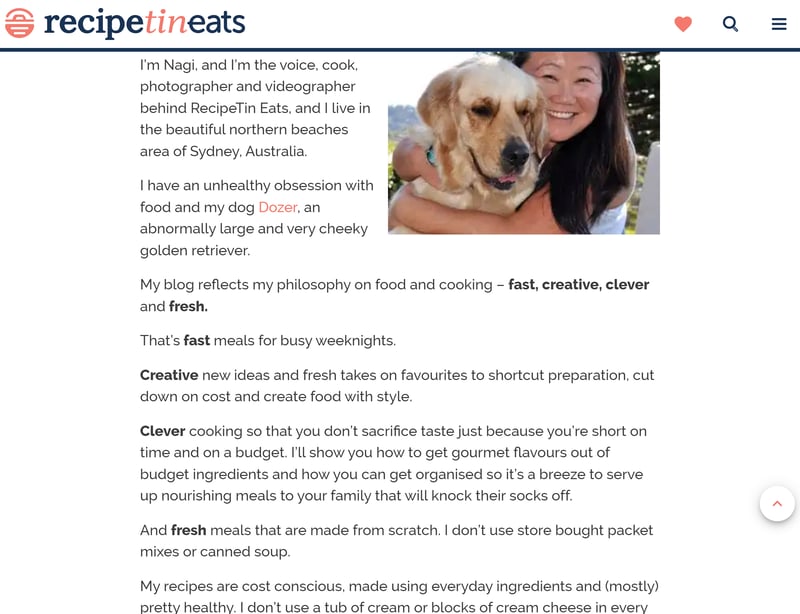
What sets your food blog apart from the rest? Briefly explain your philosophy to your audience (Source: recipetineats).
3. A memorable name (and domain)
If you've seen 'The Founder', you know just how important a catchy name is. Make sure that your blog's name is both powerful and relevant to its content. Pasta Grammar is a YouTube channel/blog that specializes in Italian food while The Woks of Life recreates a range of Chinese and Chinese-American dishes.4. Plate up your texts and images
We eat with our eyes making well-written text and photos absolute musts for a successful food blog. If you can't show what you've made and describe how you did it, you might as well not blog at all. Make sure that the recipe is presented clearly (and accurately) and that the steps for making it and end result are properly showcased.Some food blogs are more textual than others. If writing isn't your strong suit, ask yourself why you want to share the dish with your audience. By reformulating your answer, you've got an introduction to the recipe. After that, list the ingredients and amounts needed, and finally, the steps in creating it.
The same goes for photos on your blog: Not only do you want to make your readers' mouths water, but also, give them visual clues to check how they're doing along the way. We recommend investing a bit of time in learning the basics of food photography.
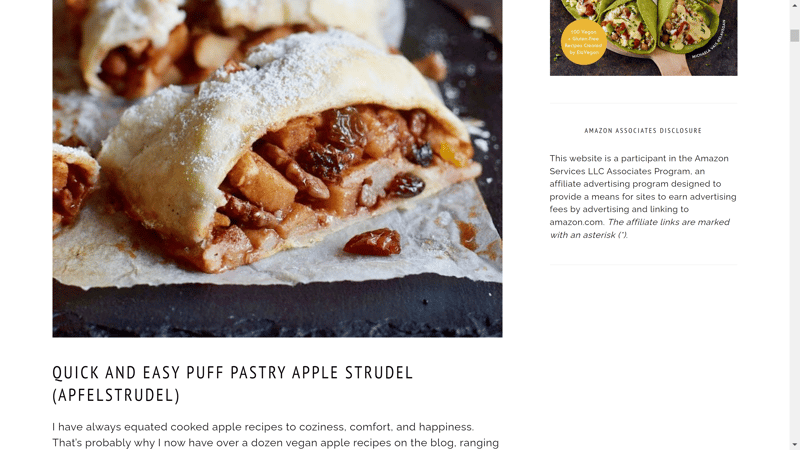
One look at the apple strudel makes you want to fire up your oven, doesn't it? (Source: Ela Vegan)
5. Select the right blogging platform
If you've come up with a concept, settled on a name, and are confident in your writing and photographic abilities, all that's left to do is create your blog. You'll have a number of options for this, which we'll briefly explain below.
Choosing the Right Blogging Platform
Right off the bat: We assume that, as an amateur food blogger, you aren't able to code a website on your own and don't have the budgetary means to pay pros to do it for you. Of course, both of these methods are completely valid, however, we'll concentrate below on the "easier" ways to do this, for those without IT skills or sizable budgets.
Simple, Free Blogging Platforms
A blog is perhaps the "simplest" kind of website: Most blog articles are structured similarly, requiring only a text editor and a page where the content can be hosted. Luckily, there are numerous free blogging platforms, where it's possible to do exactly this.
One platform that's been around for a while is Blogger. Although it now belongs to Google, it's good for personal blogs. Other free platforms include Tumblr (for image-heavy content) or Medium (for more text-based blogs).
Most free blogging platforms are only designed for personal blogs: If you're not expecting a large number of visitors (and just blog for fun or sharing with friends and family), they'll definitely meet your needs. However, since you'll have to make do without a custom domain and a limited selection of features, they aren't ideal for professional food blogs intended for a large audience.
Free
Easy to set up and manage
Include all important blog features
Not particularly professional (no custom domain)
Limited features and design options
Difficult or impossible to monetize
Content Management Systems
If you have greater ambitions for your blog and are ready to familiarize yourself with a more intricate platform, a content management system (CMS) is worth a try. The most important elements of a website come pre-configured, which makes setup (compared to manual programming) significantly easier and possible for those without any programming skills.
Another advantage: CMSs like WordPress are open source and free to use. To get your food blog online though, you will need to pay for webspace and a domain.
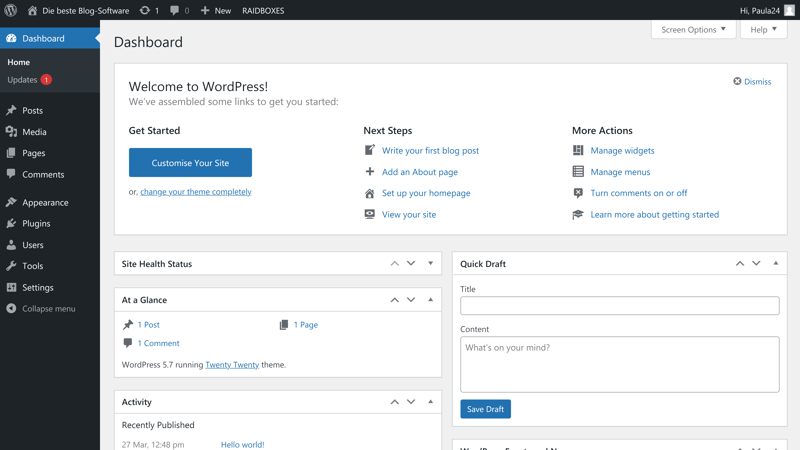
WordPress is the most popular CMS on the planet, powering more than 75% of all websites.
In comparison to basic blogging platforms, a CMS is also far more complicated. Chances are that you'll need to read or watch a few tutorials in order to familiarize yourself with its basic features and capabilities.
Flexibly design a website
Lots of templates, features, and plugins
Platforms are usually free
Pay for your domain and hosting
More complicated to use than blogging platforms and website builders
Website Builders
Website builders represent a solid compromise between basic blogging platforms and more intricate CMSs. These online services offer visual editors that allow users without any programming skills to easily put professional websites together.
The range of features and design options vary from builder to builder, however, the most important tools, such as those for blogging, are available everywhere.
Website builders offer subscription packages: You pay a fixed price per month that includes everything (hosting, SSL, and a custom domain for a year). Said differently, you don't need to worry about anything apart from designing your food blog and supplying it with content.
The main drawback to website builders is that you're cooking with a limited pantry: Each platform offers different features, elements, and layouts, but since you're not working with the source code directly, you can't add to these. This means that you'll have less creative freedom than you would with a CMS.
Easy website creation: No programming skills required
Advanced blogging features
All-in-one package
Less flexible than a CMS
Potential disadvantages in terms of SEO
Difficult-impossible to transfer a blog to another platform
The Best Website Builders for Food Bloggers
You've decided to use a website builder? Great! The next question is: Which? We tested 12 of the most popular solutions, and below, will introduce you to our TOP 3 website builders for food blogging:
Squarespace: For Visually Stunning Food Blogs

Squarespace made a name for itself with its elegant, photo-heavy templates that are ideal for food blogs. Luckily, there are a number of options designed specifically for culinary blogging, however, nearly any design can be adapted to your needs.
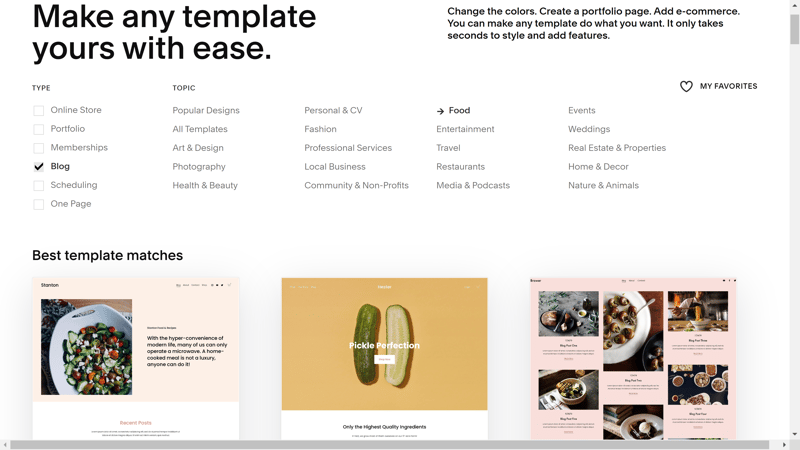
Let your dishes speak for themselves with Squarespace's image-centric templates.
Why Squarespace is a good food blogging platform
Squarespace's blogging features include all of the most important tools you'll need as a food blogger. In the platform's editor, you'll work with text, images, videos, and other elements, integrating them into posts just as you would content blocks. Entries can be posted immediately or scheduled to go live later on.
Apart from that, you can also specify authors, link social media channels, and work with advanced SEO settings. Blog entries can be categorized and tagged.
Another advantage: Squarespace supports RSS feeds. Readers can subscribe to your blog as a newsletter and be informed about new posts the second they're published.
What we don't like
Unfortunately, Squarespace doesn't have an integrated autosave feature. When working directly in the editor, make sure that you regularly save, so that you won't lose any progress if your browser or system unexpectedly crashes.
Squarespace users should also keep in the back of their minds that its templates (and by extension, websites or blogs created with it) all look somewhat similar. This is a general disadvantage of website builders, however, Squarespace websites are perhaps the easiest to recognize.
Wix: User-Friendly All-Arounder

For us, Wix is the most versatile website builder on the market, storming to first place in our review series. The Israeli platform offers a wide range of features, is easy to use thanks to its intuitive drag and drop editor, and provides solid templates. Food bloggers in particular can look forward to a number of appetizing designs:
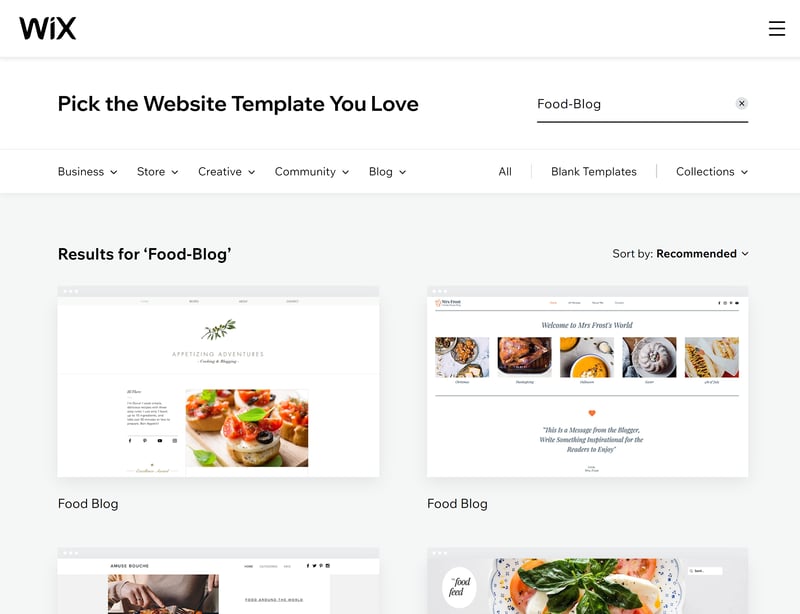
Wix won EXPERTE.com's test and is a solid choice for food blogs.
Why Wix is a good food blogging platform
When it comes to food blogging, Wix is solid, offering users a whole range of different features: In the editor, you can easily embed photos, videos, and other content into posts, group your texts into categories, and tag them. Posts can be published immediately, or scheduled to go live later on. In addition, it's possible to enable comments and offer visitors a search tool for easy navigation.
What we don't like
Wix doesn't support RSS feeds. Worse still, you can't change your blog's template without losing all of your progress up to that point: If you want to revamp your blog's design, you'll need to start from scratch.
MyWebsite by IONOS: Versatile Website Builder With Solid Blogging Features
MyWebsite by IONOS requires somewhat more getting used to but offers both more features and customization options than many of its competitors. Blogs can be created starting with a Plus subscription.
You'll set the basic design parameters for your blog in layout mode, while post mode is where you'll handle everything relating to your blog's entries. Just like in the regular website editor, you're able to add content by dragging and dropping it.
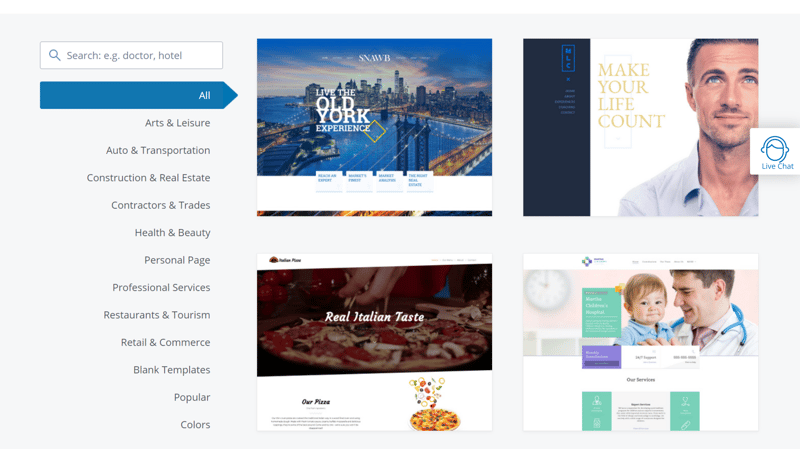
You can easily create and monetize a food blog with MyWebsite by IONOS.
Why MyWebsite by IONOS is a good food blogging platform
The website builder offers access to many of the most important food blogging features: You can tag your posts, assign them custom URLs, and schedule publication in advance. If your food blog has multiple contributors, you can easily manage their access rights, so that they can post on their own.
RSS feeds are supported, but that's not all: One of the most useful features that MyWebsite by IONOS serves up is the ability to import entries from other blogs via RSS feed. Very few of the platform's rivals offer this functionality.
What we don't like
We like what's under the hood with MyWebsite by IONOS, however, its interface is dated and its usage concept isn't anywhere as intuitive as what we've come to expect from website builders.
Other Providers
Squarespace, Wix, and MyWebsite by IONOS are just three possibilities - There are plenty of other website builders out there that can help you create your food blog. Below, we've provided the complete ranking of all platforms from our sample:
4 Ways to Earn Money as a Food Blogger
And now the million-dollar question: How to earn money with your passion for food and cooking? There are a number of ways, all of which have advantages and disadvantages. Below, we've summarized what we think are the best four:
Ads
The most straightforward way to monetize your food blog is to lease out its space to advertisers. By integrating relevant banner or text ads, whenever a visitor clicks on one, you'll receive a small commission.
You can use a dedicated ad network to integrate advertisements on your blog. The most well-known of these is Google Adsense, but there are others as well, like Ezoic and Mediavine.
Advantages and Disadvantages of Ad Monetization
The more visitors your blog has, the more revenue you'll earn
Integrating an ad network is very easy
Users might find ads to be annoying and intrusive
Limited control over ad content
Affiliate Marketing
Affiliate marketing (which EXPERTE.com uses) pays a commission whenever a visitor to your blog opens a link to a product and purchases it. There are no disadvantages for your readers since the price they pay has no correlation to the affiliate link.
For food blogging, you can link to online stores selling cooking utensils or appliances that you use, so that your audience can come even closer to recreating the dish you've prepared. Another idea is to link to specific ingredients, such as spices or pantry staples that appear in your recipes or posts.
Advantages and Disadvantages of Affiliate Link Monetization
Practical for your audience and offer true added value
Easy to integrate
High volume necessary to generate enough revenue
Difficult to find the right affiliate partner
Collaboration and Sponsors
Our third suggestion for generating revenue from your food blog is to pursue sponsorships or collaborations with businesses that have something to do with your blog's content. Kitchenware or food companies immediately come to mind: You can use their products in a specific recipe, or even dedicate an article to a taste test or side-by-side comparison. Competitions and giveaways are also good ways to generate hype for sponsorships.
Of course, finding a sponsor or someone to collaborate with is easy when you already have the right contacts or a deep network of friends that you can call in favors from. Don't overlook smaller partners, since regional cooperatives, local businesses, or start-ups can offer much-needed help and exposure for hobby bloggers.
Advantages and Disadvantages of Monetization Through Sponsorships/Collaborations
Possible to generate significant revenue through the right sponsorship
Your audience can win prizes
Collaborations can introduce someone else's audience to your blog
Difficult to find the right partner when starting out
Important to be selective, so that your reputation won't suffer
Sell Your Own Products
Our final suggestion is to offer your own products or merch directly to your audience. These can be physical, such as a cookbook of your best recipes or a t-shirt with your logo on it, or digital (such as a recorded cooking series, exclusive video content, etc.). Adding an online store to your website is simple regardless of whether you're using a CMS or a website builder.
Advantages and Disadvantages of Monetization Through Product Sales
Passive income source, after the product is made
High earning potential
Creating good products that customers are willing to pay for is time-consuming
Conclusion
Food blogs are creative outlets for those who enjoy cooking and eating. Apart from a passion for the culinary arts, you'll also need to identify a specific niche or area that is both underserviced and that you can sink your teeth into. Writing and food photography skills are also important. But it's not all work: Food blogs can generate steady streams of income through ads, affiliate marketing, sponsorships, or product and merch sales.
Creating a food blog is easy, even on your own, thanks to blogging platforms, content management systems (CMSs) like WordPress, and website builders, such as Squarespace. A CMS offers maximum flexibility, however, website builders are easier for beginners to use. We've prepared comprehensive reviews of all 12 website builders we assessed in our EXPERTE.com comparison.
FAQs
Food bloggers write and post about food. Most prepare and cook the dishes themselves, sharing creations and recipes with their audiences. Other food bloggers are foodies, who don't cook, but travel to interesting locations and document local delicacies or review restaurants, brands, or types of products.
Before launching your food blog, do some research and find an interesting niche or area that you'd like to explore that isn't overcrowded with other bloggers. There are thousands of food bloggers preparing the "best" recipes for pizza or fried rice, so think outside of the box. Once you have an idea, you can choose from free blogging platforms, a CMS like WordPress, or website builders like Squarespace.
There are lots of ways to monetize a food blog: You can integrate ads, engage in affiliate marketing, work with sponsors, collaborate with other bloggers or companies, or sell your own products and merch, such as cookbooks, cooking courses, or t-shirts.



























